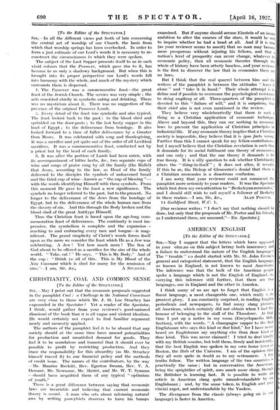[To the Editor of the SPECTATOR.] SIR, -- In all the different
views put forth of late concerning the central act of worship of our Church, the basis from which that worship springs has been overlooked. In order to form a just estimate of our Lord's words it is necessary to re- construct the circumstances in which they were spoken.
The subject of the Last Supper presents itself to us in such vivid colours that the Passover, which gave rise to it, has become to us only a shadowy background. But when this is brought into its proper perspective our Lord's words fall into harmony with the whole, and much of the mystery which surrounds them is dispersed.
1. The Passover was a commemorative feast—the great feast of the Jewish Church. The service was very simple ; the acts consisted chiefly in symbolic eating and drinking. There was no mysticism about it. There was no suggestion of the presence of the original Passover Lamb.
2. Every detail of the feast was symbolic and also typical. The feast looked back to the past : to the blood shed and sprinkled on the door-posts ; to the last hasty supper in the land of Egypt ; to the deliverance from bondage. It also looked forward to a, time of fuller deliverance by a Greater than Moses. It was celebrated with song and thanksgiving, It was a sacrifice and yet quite out of the order of all Levitical sacrifices. It was a commemorative feast, conducted not by a priest but by the head of each family.
:3. It was after the portion of Lamb had been eaten, with its accompaniment of bitter herbs, &c., two separate cups of wine and songs of praise sung by all the family (the Hallel) that Jesus, according to the law, as Head of the family delivered to the disciples the symbols of unleavened bread and the third cup of wine—known as " the cup of blessing "- with the words identifying Himself with these symbols. From this moment He gave to the feast a new significance. The symbols no longer referred to the past, but to the present. No longer to the deliverance of the Jews from the bondage of Egypt, but to the deliverance of the whole human race from the slavery of sin. And this through the Body broken and the blood shed of the great Antitype Himself.
Thus the Christian feast is based upon the age-long com- memoration feast of deliverance. The continuity is most im- pressive, the symbolism is complete and the expansion-- reaching to and embracing. every race and tongue—is mag- nificent. The grand simplicity of Christ's words forces itself upon us the more we consider the feast which He as a Jew was celebrating. A Jew ! Yet how much more The Son of God about to be offered as a sacrifice for the sins of the whole world. " Take, eat ! " He says. " This is My Body." And of the cup : Drink ye all of this. This is My Blood of the New Covenant which is shed for many for the remission of


































 Previous page
Previous page